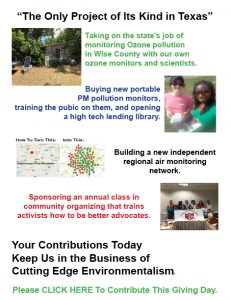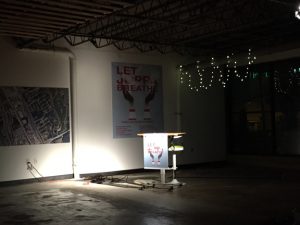Uncategorized
Vote for Us and Ours
CLICK HERE TO VOTE FOR THE GREENSOURCE AWARDS 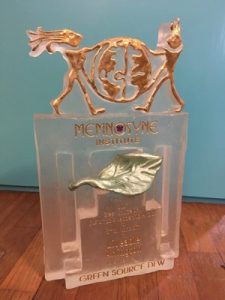
Downwinder board member Evelyn Mayo for Coke Buchanan Volunteer of the Year
DFW Air Research Consortium for Environmental Science and Innovation
GoodWork Co-Working Space for Environmental Science and Innovation
The GreenSource DFW Leadership Awards are one of the only ways, and certainly the most popular way, the DFW environmental community recognizes accomplishments among its own ranks. They’re now in their seventh year and the end-of-the-year awards dinner where the winners are announced is the rare Big Tent event on the local green calendar.
There’s a nomination process, followed by a selection committee within Green Source staff, and then they open up the list of final nominees to a popular vote of sorts. We’re in the voting period now. And in this election, you can vote every 24 hours during the two-week voting period, ending September 30th. So you really can vote early and often…legally.
There are awards for green-writing journalists, green groups and green people, er activists. This year we’re lucky to have direct ties to three nominees and we hope you do vote for them often over the next three days.
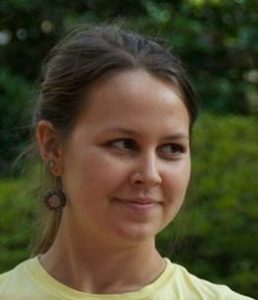 Downwinders board member Eveyln Mayo is nominated for the Coke Buchanan Volunteer of the Year Award. This award goes to a person showing outstanding volunteer service to a green cause or organization.
Downwinders board member Eveyln Mayo is nominated for the Coke Buchanan Volunteer of the Year Award. This award goes to a person showing outstanding volunteer service to a green cause or organization.
We’ll let the text accompanying her GreenSource nomination speak for itself:
“At 23, Evelyn Mayo may be one of the youngest environmental organizers in DFW, but she has the bearing of a veteran eco-warrior. Arriving in DFW fresh out of college only 14 months ago, she joined the board of Downwinders at Risk and has helped revitalize that group by leading it into new areas of program work and attracting a team of inspiring 20 and 30-something women to join her.
Evelyn has been the Chair of Downwinders’ Particulate Matter Campaign Committee since its creation last Fall. In that role, she’s helped raise the profile of a long-ignored pollutant.
She initiated and helped host community meetings on the dangers of PM. She’s a liaison between Downwinders and the North Texas Transit Riders to help better protect a population that’s routinely exposed to high levels of PM pollution.
She coordinated the deployment of Downwinders’ portable PM monitors in the Joppa neighborhood that revealed high levels of PM there when City staff was trying to reassure residents with the readings of an EPA monitor nine miles away.
Now she’s helping to assemble a “Justice for Joppa” support committee that can assist the neighborhood in addressing a long list of grievance and needed reforms. And if that weren’t enough, she’s also helping direct Downwinders’ “Green Streets” bus electrification campaign.
It was the portable air monitoring Evelyn coordinated on behalf of the Joppa community that sealed the fate of the two batch plants seeking permits to set-up shop there. Anyone attending the City Council meting in March when the plant permits were debated heard constant references to the dangers of PM – even by batch plant lobbyists themselves. That was Evelyn’s work. That citizen monitoring project has also given new impetus to the city of Dallas joining a regional air quality monitoring network, which would be about the most important local air quality development in a long while.
Evelyn has become a reliable bridge between communities of color and the local environmental scene. Not just in Joppa, but throughout DFW. She’s looked upon by both residents and activists as a hardworking honest broker for their concerns. In this capacity she’s been responsible for re-focusing Downwinders as an Environmental Justice advocacy group, and re-setting the environmental agenda in Dallas as a whole.”
And that’s why we want you to vote for Evy.
Downwinders and its partners in the DFW Air Research Consortium are nominated for the Environmental Science and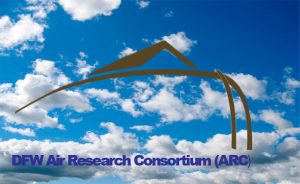 Innovation Award for building the North Texas Clean Air Network – the first local, independent regional air monitoring network in the state.
Innovation Award for building the North Texas Clean Air Network – the first local, independent regional air monitoring network in the state.
In nominating DFW ARC, GreenSource listed the advantages of having such a network in place: “There are the impacts one can think of now and the ones we can’t imagine on this end of things. In the short term, monitors along a facility’s fence line might act like 24/7 environmental beat cops and discourage polluters from even thinking about shady discharges “at night, weekends and holidays” that would have been routine before. Plano proposed to use the network to help time traffic lights and find the pattern that most reduced vehicle pollution along major streets. The public and officials could track pollution levels in real time during accidents and fires, providing better evacuation routes and warnings. You can track work productivity, school absenteeism, ER asthma visits, heart attacks and strokes with pollution levels and then estimate how much economic cost there really is to “bad air days.” Neighborhoods can map their own air pollution burdens, showing that they’re already breathing higher levels of pollution than other parts of town.”
The organization of ARC itself is a model for collaboration among scientists, citizen groups, and local officials to harness technology for the public health. It’s been a very effective organization in a relatively short amount of time.
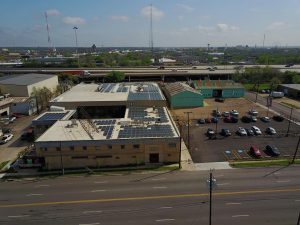
Finally, Downwinders new home, the GoodWork Coworking Space south of Downtown Dallas has also been nominated for the Environmental Science and Innovation Award. GoodWork is the first coworking space in the nation focused on inclusive sustainability and wellness for entrepreneurs, non-profits and innovators, powered by the largest concentration of solar panels in Central Dallas (provided by Downwinders’ Sue Pope Fund). D Magazine called it the “superfood of coworking.”
What’s been really interesting to watch since we moved here in February is how many South Dallas entrepreneurs, non-profits and freelancers have found a home where they feel comfortable, forming networks and communities that weren’t available to them before because nothing like GoodWork was around to provide it. Many of them are grassroots disruptors of the status quo in their own areas of expertise just as Downwindes tries to be in air quality and social justice. You won’t meet your typical co-worker type and that suits us fine because we’re not your typical environmental group.
We wish all the nominees luck, but these three maybe more so. See you at the awards dinner.
GIVING DAY PAYS FOR COMMUNITY ORGANIZING

After almost 30 years of illegally dirty air, Downwinders at Risk still employs the only full time staffer devoted exclusively to DFW air pollution problems.
And they do it with your contributions.
CLICK HERE
TO SECURELY CONTRIBUTE TO DOWNWINDERS
What Your
Giving Day Contribution Pays For:
Community Organizing in Joppa
 From its founding Downwinders has fashioned itself as a grassroots group employing basic community organizing principles.
From its founding Downwinders has fashioned itself as a grassroots group employing basic community organizing principles.
This makes us different than most other green groups, who see themselves advocating for causes. We advocate on behalf of people in neighborhoods and towns who are getting shat on by industry, elected officials, bureaucracies, or all of the above.
The latest example is in Joppa, Dallas oldest Freedman’s township.
Surrounded on three sides by heavy industry and freeways, and on the fourth by a landfill and the Trinity River, Joppa is a small neighborhood that looms large in Dallas history. It’s where “South Dallas” began.
We were invited by Joppa residents to use our new portable PM monitors to sample their air prior to the March City Council vote on two new batch plants. That sampling helped defeat those batch plants.But instead of continuing to play “whack-a-mole” with industrial facilities that keep popping up in Joppa, we  proposed a sustained effort to start undoing the environmental racism that brings them to that community in the first place. We wanted to address the underlying problem, not just the symptoms.
proposed a sustained effort to start undoing the environmental racism that brings them to that community in the first place. We wanted to address the underlying problem, not just the symptoms.
Residents and their supporters hammered out the idea of an“Environmental Preservation District” that would systematically address each of the environmental threats identified by the community, including buffer zones, new pollution controls on local industry, and continuous air monitoring.
And so this coming Monday evening Downwinders will be hosting the first meeting of the “Let Joppa Breathe” Alliance, a new network designed to help press the agenda of the Joppa Freedman’s Township Association citywide and win structural changes.
 This isn’t going to be a short fight. It’ll take years. It’ll take a lot of focused energy. It’ll take a lot of people. But the goal of being able to use a reborn Joppa as a model of how to undo environmental racism in other parts of the City is worth it.
This isn’t going to be a short fight. It’ll take years. It’ll take a lot of focused energy. It’ll take a lot of people. But the goal of being able to use a reborn Joppa as a model of how to undo environmental racism in other parts of the City is worth it.
No other green group in DFW has the resources or the mandate to carry out this kind of long-term community organizing campaign. With you contributions, we’ve been doing them for almost 25 years.
GIVING DAY PAYS FOR INSTITUTIONAL CHANGE
We don’t have an home office
in Austin, or Washington, or NYC.
Our only office is right here in DFW.
We don’t have a national agenda.
We have local agendas that have national impacts.
CLICK HERE
TO SECURELY CONTRIBUTE TO DOWNWINDERS
What Your Giving Day Contribution Pays For
Institutional Change:
Creation of the North Texas Clean Air Network
 currently operate.
currently operate. But we also wanted to make sure it would be a tool for citizen empowerment, so we insisted on having public and public health advocate seats on the board overseeing the new network.
But we also wanted to make sure it would be a tool for citizen empowerment, so we insisted on having public and public health advocate seats on the board overseeing the new network.
Each governing entity joining the network appoints a staff person or elected official. But they also appoint a public representative as well.

 If there’s one critical difference between Downwinders and most other green groups, it’s that we know process is as important as policy. You can improve policy, but the really lasting changes occur when you also change the process itself. When you commit institutional change on behalf of citizens.
If there’s one critical difference between Downwinders and most other green groups, it’s that we know process is as important as policy. You can improve policy, but the really lasting changes occur when you also change the process itself. When you commit institutional change on behalf of citizens. This new independent network will eventually supersede the obsolete system currently run by the state and federal government. It’ll become the default way DFW residents check their air. It’ll bring challenges and changes to environmental enforcement, zoning and land use planning, and even the timing of traffic lights. It gives citizens and local governments a powerful new tool.
GIVING DAY PAYS FOR CITIZEN SCIENCE

Downwinders is a entirely local group,
run by board members who live in DFW,
and funded by local contributions. Like yours.
CLICK HERE
TO SECURELY CONTRIBUTE TO DOWNWINDERS. THANKS
What Your Contribution Pays For:
Citizen Science
In the past 18 months, Downwinders at Risk has become the leading sponsor of environmental Citizen Science projects in DFW. Your Giving Day contribution today will help us pay for the following:
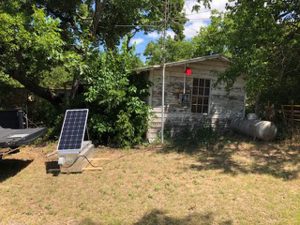 The Wise County Ozone Project
The Wise County Ozone Project
 powered portable ozone monitoring station (ATLAS) so we could deploy them anywhere in Wise County. This July they were installed on site and now a non-profit clean air group is performing the air quality monitoring duties of the state and federal government – all for about $13- $14,000 dollars.
powered portable ozone monitoring station (ATLAS) so we could deploy them anywhere in Wise County. This July they were installed on site and now a non-profit clean air group is performing the air quality monitoring duties of the state and federal government – all for about $13- $14,000 dollars. This is the purest piece of citizen science we’re committed to. We’re not sure what we’ll find. But we’re not afraid to take on a basic job government is supposed to be doing.
This is the purest piece of citizen science we’re committed to. We’re not sure what we’ll find. But we’re not afraid to take on a basic job government is supposed to be doing.Portable Monitors: Training and Lending Library

Shannon Gribble and Cresanda Allen on a monitoring run in Joppa
Earlier this year we bought two portable Particulate Matter (PM) monitors that had just come onto the market from a
New Zealand company, Aeroqual. Calibrated at the factory, these monitors were better than anything else on the market for the price – $1600 each.
Shortly after taking delivery, Joppa residents asked us to bring them to that neighborhood to sample what the air they were breathing was like even before two proposed new batch plants opened there. Our monitors recorded levels of PM pollution much higher than those found at the only official PM monitor in Dallas County hosts, nine miles away – the same monitor city staff was trying to use to say how clean Joppa air was. Our results sealed the defeat the new Joppa batch plants.
With the help of the Dallas Sierra Club and others contributing to the May 22nd Joppa benefit, we were able to buy a third Portable PM Monitor for use exclusively in Joppa, where it now resides 24/7. This December we’ve budgeted to buy two more, giving us a total of five by the end of the year.
Meanwhile, EPA and Areoqual established a national partnership for air quality monitoring, enhancing the credibility of our monitors and our results.
 This Saturday, members of our PM Committee will be hosting free public training sessions on how to use our portable monitors in the field. When you’ve completed three field trips with our team, we’re giving you the chance to ‘”check-out” the portables for your own use or to further help us research local PM levels at specific sites.
This Saturday, members of our PM Committee will be hosting free public training sessions on how to use our portable monitors in the field. When you’ve completed three field trips with our team, we’re giving you the chance to ‘”check-out” the portables for your own use or to further help us research local PM levels at specific sites.
Today is Giving Day…..
Fresh from the Vault: Open Records Act Results from the Dallas Office of Environmental Quality
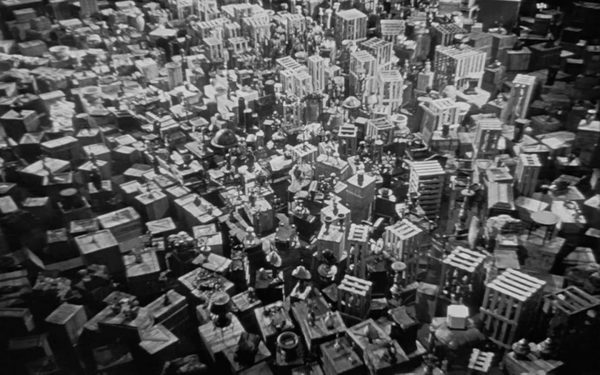
Last month we requested the City of Dallas’ Office of Environmental Quality files concerning air quality monitoring going back a few years. We wanted to know more about how City staff chose the Texas Nature Conservancy’s “Breathe Easy” study as its first air monitoring project through a process of…well, there wasn’t exactly a process was there?
Here’s some highlights from the materials we reviewed so far:
Despite criticism, OEQ Staff is recommending using the same air monitors for its own study that Downwinders used in Joppa.
OEQ staffers have criticized Downwinders’ portable monitoring in Joppa…despite the lack of any city monitoring up to that point in the neighborhood. Something about the lack of reliable data. But lo and behold, OEQ staffers seems to have recommended not only the same company (New Zealand-based Aeroqual) to the Nature Conservancy for its stationary monitors, but also exactly the same portable air monitors. We told you they were good.
Any local university scientist who’s worked with Downwinders is blackballed.
Dr. Kuruvilla John, Professor and Chair Department of Mechanical and Energy Engineering at the University of North Texas was “…biased because funded by Downwinders” according to one meeting summary and blackballed by OEQ staff as a City technical advisor for the Breathe Easy project. Dr. John’s sole sin was to get paid as a contractor in 2015 by Downwinders to perform a single study using the state’s own computer model for DFW smog. Before ruling him out, no one on OEQ staff mentioned that Dr. John’s modeling and study was endorsed by a unanimous Dallas city council vote recommending the EPA take more proactive measures to reduce smog pollution.
One wonders if his collaboration with Downwinders and other citizens groups in the DFW Air Research Consortium have made UTD’s Dr. David Lary similarly verboten to OEQ staff.
Dallas City staff in-kind contributions to the Texas Nature Conservancy “Breath Easy” project are very, very large.
To date, the partnership between the City and the Texas Nature Conservancy has raised almost $300,000 in grant money for a study involving nine schools. But that total pales in comparison to the in-kind contributions the city is making to the effort over both its developmental period and it two-year run. For example…
Combine all the staff time over 3-4 years with data services costs and you could well have a multi-million dollar donation from the City of Dallas to the Texas Nature Conservancy, courtesy of your tax dollars.
OEQ staff likes the idea of a new air monitoring network…in other cities.
As one OEQ staffer put it: “We’re looking at air monitoring programs in states and cities. In Minneapolis/St. Paul the state agency is installing low cost (and low resolution) monitors in every zip code. In L.A. they are installing 100 monitors citywide. Baltimore, Chicago and Lafayette all have enhanced monitoring programs. Here the TCEQ has zero interest in any of these projects. The EPA staff are very interested, but cannot offer any financial support.”
A OEQ staffer sought a job with the Conservancy even as the Breathe Easy project was taking shape.
“We are teaming up with the Nature Conservancy and their new Urban Conservation Director ( a position I interviewed for in early 2017….)”
As you piece together the email chains and date memos, it’s clear that if it weren’t for the considerable support from the City of Dallas, the Nature Conservancy’s Breathe Easy air monitoring project would…need a lot more grant money.
Why has OEQ staff committed so much time and money to a two-year study of nine schools while dismissing the lesser expense and effort of joining a regional network of air monitors many times that size? A real time air quality network modeled on the very kind OEQ staff seem to admire from afar in other cities? That’s an answer that we haven’t found in the files yet.
But it’s something to keep in mind for the re-scheduled September 24th Quality of Life Committee meeting where presentations about both the TNC/City’s private study and the DFW Air Research Consortium public network will be featured.
2018: Worst Smog in Five Years…and Ozone Season Isn’t Over
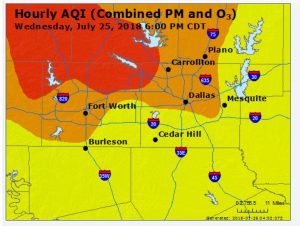
With months of “ozone season” still to come, 2018 is already one of the worst years of DFW smog pollution this decade.
As of August 9th, six out of the 20 North Texas ozone pollution monitors have registered at least four days when the average concentrations of smog were 80 parts per billion or higher over any eight-hour period. The current EPA ozone standard is 70 ppb over eight hours. Most scientists who study ozone pollution recommend between 60 and 65 ppb.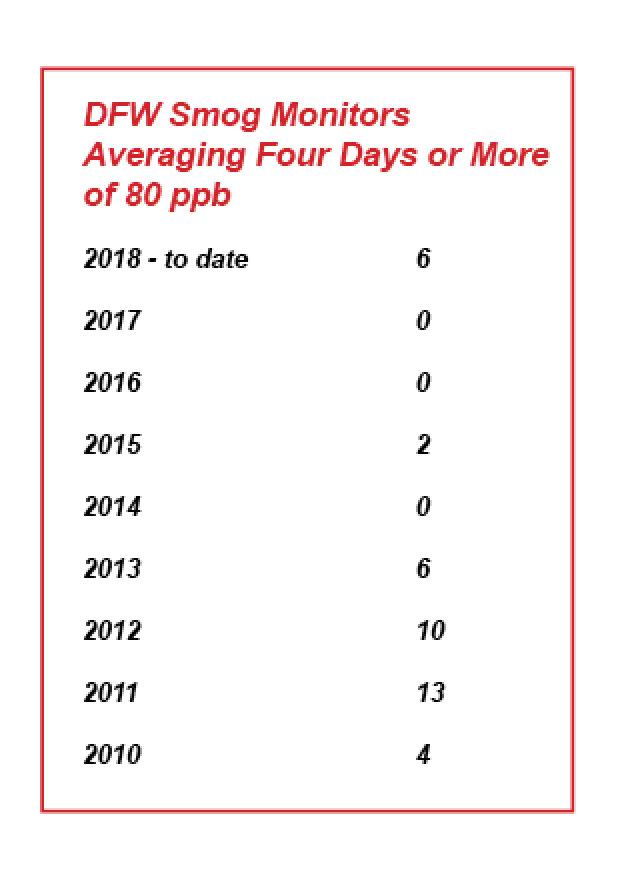
Unfortunately our lungs don’t breathe averages. Regulatory accounting smooths out the highs and lows. This summer has seen at least five sites record smog in the 90-95 ppb range for more than an hour. That’s very hazardous breathing.
There’s no question there were public health consequences to those extreme air pollution levels. Asthma attacks were triggered, COPD patients were gasping, but also strokes and heart attacks. We just don’t know how many…until after the fact.
It’s the first time in two years that any DFW monitors have had 8-hour averages of 80 ppb or above, and the first time since 2013 since there been at least six. In fact, this year’s total number of 80-or-above monitors is almost equal to the total number from the last five years combined.
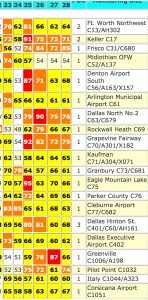
The last week of July was a bad one for DFW breathers.
Besides the number of high smog readings, the location of the monitors recording them should be of concern. Five out of the six registering the highest numbers this year have long histories of being among those registering the highest numbers in past years – Grapevine, Eagle Mountain Lake, Dallas Hinton, Dallas North and Frisco. Only Cleburne might be considered an outlier. The fact the same sites keep popping up over and over again means the strategies for reducing smog pollution aren’t working when put to the test like this July’s heat wave.
But of course that assumes there are any strategies for reducing smog in DFW. And technically there are. But they aren’t being vetted for their effectiveness, and they aren’t being enforced, and some are even being rolled back. After 27 years of continually violating the Clean Air Act for smog pollution, there’s nobody in any level of government working on a cogent plan to get DFW into compliance. Law and order rhetoric from Austin and Washington not withstanding.
What made July smog worse than usual was the heat. Climate scientists are telling us we’re going to be having more summers like 2018, not fewer. So this year’s levels are probably a precursor, not an aberration. But that’s a hard sell to elected officials whose campaign accounts depend on denying the science.
The punch line to this year’s sudden and dramatic spike in higher smog levels? It might still result in officials taking the Orwellian stand that the air in DFW is getting better. How is such a thing possible? Through the wonders of regulatory math.
EPA’s classification of how bad or good air quality is in any region is done by taking the 4th highest annual reading from each monitor and then keeping a rolling average of three years’ of those annual 4th highest numbers for each monitor. For this year, only the 4th highest numbers for 2016, 2017 and 2018 are included in the rolling average. Denton did see high numbers in 2015, but those are all now rolling off and not being counted.
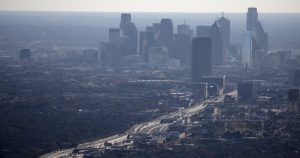
Up to now those 2015 numbers have kept the regional smog average in Denton at 81 ppb despite relatively light ozone seasons in 2016 and 2017. Now that that 2015 high number is rolling off, it would take the Denton site having 4 separate days of 90+ ppb smog in the next 90 days to make the average rise back up to 81 ppb. If that doesn’t occur, then the Denton average could drop to somewhere in the mid-to-upper 70 ppb range.
Should that happen, expect to see lots of regional back-slapping among officialdom for bringing down that Denton number and “continuing to make air quality progress.” Even as more monitor sites see higher smog numbers, officials will declare their anti-pollution measures are working splendidly. But that will not be the case, and you should not be misled.
While there might be a bit of specific progress made at the Denton monitor site, the increase in the number of other sites registering higher levels of smog they haven’t seen in years negates it. If all it takes is a heat wave to send two years of lower numbers down the drain, and the future is full of heat waves, then that’s not really progress, is it? We’re forced to put our fate in the hands of the weather instead of our own planning. Not very proactive, but that’s the state of air pollution control in DFW in 2018: “Please Dear God, keep it cool this summer.”
Even before the Trump Administration came into office the EPA wasn’t enforcing provisions of the Clean Air Act that DFW blew by ages ago – not correctly classifying its non-compliance, not requiring controls on major polluters, providing one extension after another. Now of course, there’s total abdication of even the pretense of striving toward cleaner air for its own sake.
Which is why if any progress is going to be made over the next 2-3 years, it must be made at the local level. No one else gives a damn. Officially.
Joppa Benefit Shows What a New Dallas Black-Green Alliance Could Look Like
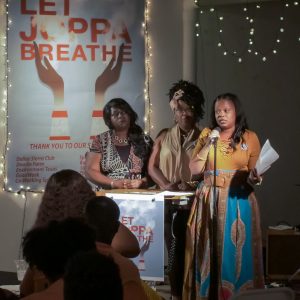
L to R: Jabrille McDuffie, Natasha Dunn and Temeckia Derrough of the Joppa Freedman’s Town Association
We raised another $3600 for air monitoring in Joppa amidst the most diverse “environmental” Big D event many could ever remember, with a program that won rave reviews from an overflow crowd. If you squinted, you could see the future. Thanks.
By almost any measure, the May 22nd benefit for air monitoring in Joppa fit the definition of success.
Packed crowd. Check
Engaging Program. Check
Moneymaker. Check
Political Game Changer…..Depends on what happens next.
As important as having a full house…was WHO was in the house. Here was a table of 10th Street Historic Neighborhood Association members, there was a table of Sierra Club members. Frazier Revitalization members sat next to Dallas Green Alliance leadership. For every green group represented there was a South Dallas neighborhood group also present and accounted for.
Not only was the event a success for Joppa, it has the potential to inaugurate a new era of cooperation between green and black groups in Dallas. One of the last orders of business were members of the Joppa Freedman’s Town Association reading a long list of needed reforms to be included in what they called the “Joppa Environmental Preservation District” that could be a model for other historically distressed Dallas neighborhoods. What started in Joppa could end up traveling to West Dallas, Pleasant Grove and Cedar Crest.

It was clear from the start this wasn’t going to be a staid program of speakers and performers. After about 30 minutes of eating, drinking, and mixing in the industrial chic of the GoodWork co-working space Downwinders now calls home, a booming ten-member section of the Sticks Mania professional drum line marched down Good-Latimer and directly into the event space. For the next 20 minutes, a sizable portion of a crowd at a Dallas environmental event could be seen sliding into outright twerking behavior, a probable first. You can see a video sample of Sticks Mania’s performance on our Facebook page here.
And you can see a gallery of highlights from the benefit on our website here courtesy of Norman J Jones.
Dallas’ own spoke word artist Rage Almighty did a great job of playing ringmaster for the evening’s progressive variety show as well as wowing the audience with his own verbal gymnastics and gyrations through the English language and race politics.
District 7 Council Member Keven Felder showed-up to give a rousing welcome and rally his constituents to be on guard for the re-submittal of batch plant permits by Martin Marietta. He also promised he was working on bringing cleaner industries to District 7 and Joppa.
 Keith Price and Douglas Carter performed two dramatic monologues from “The Freedmens” fresh off its run at the Wylie Theater downtown. They
Keith Price and Douglas Carter performed two dramatic monologues from “The Freedmens” fresh off its run at the Wylie Theater downtown. They
received a standing ovation at the end, and it was the first of many times during the night the audience could be seen dabbing their eyes.
Solakio Music provided the right mix of laid back soul and jazz that buffered the different segments and set the mood for whatever was coming next.
Comic relief and some added inspiration was added by the staging of a brief 2018 graduation ceremony for this year’s Downwinders’ College of Constructive Hell-Raising class. Almost a dozen new activists now “think more like organizers” after a ten-session, five month long course in affecting change. Each got a diploma from College “Dean” Jim Schermbeck and faithfully recited the school pledge to protect people and planet.
This year’s graduates heard their convocation speaker, civil rights legend Peter Johnson, talk about all the similarities between the fight against segregation in the 1960’s and the fight for environmental justice in places like Joppa today. Then they heard Dallas singer Vicki Larkin-Tovar belt out “Keeper of the Flame” as the class song:
“I’m the keeper of the flame
The teller of the story
For the ones that came before me
For the little pilot lights waiting to ignite
Like fireflies in the rain
Keeper of the flame”
 After that it was Joppa’s turn to speak. Temeckia Derrough, Natasha Dunn, and Jabrille McDuffie from the Joppa Freedman’s Town Association gave effusive thanks to the crowd for their support and laid out the elements for “what environmental justice in Joppa would look like.” Ms. Dunn brought many to tears in describing the group’s struggle to organize itself and remain steadfast in the face of so much pressure to stop opposing the new batch plants.
After that it was Joppa’s turn to speak. Temeckia Derrough, Natasha Dunn, and Jabrille McDuffie from the Joppa Freedman’s Town Association gave effusive thanks to the crowd for their support and laid out the elements for “what environmental justice in Joppa would look like.” Ms. Dunn brought many to tears in describing the group’s struggle to organize itself and remain steadfast in the face of so much pressure to stop opposing the new batch plants.
Among the changes sought by the residents are a switch to electric locomotives in the 100 plus year-old Union Pacific rail yard, more and better pollution controls on the industry surrounding them, buffer zones separating people from polluters, and new zoning and enforcement provisions that will help them start to reverse decades of environmental racism.
Time and again the JFTA leadership reminded everyone they’ll need all the help they can get if they hope to see any of these reforms materialize. Downwinders and the Sierra Club have both committed resources to the community. That list of partners needs to get longer. In signing-on to help build a Joppa “Environmental Preservation District” Green Dallasites have an opportunity to take a big step in addressing our own historical blindspots as a local movement. Stay tuned as we try to make it easier for groups and individuals outside the neighborhood to provide support.
Meanwhile, thanks to the big crowd, a silent auction, bartender tips, and some sizable donations from the Sierra Club and Frazier Revitalization, $3600 was raised for the purpose of buying air quality monitors for Joppa. We’re combining that with the $1600 already collected, for a grand total of $5200.
Thanks to everyone who contributed, whether it was $25 or $250. To see what your money will be buying for Joppa keep reading…..
Tonight: Show Up for Change
Like Life,
Social Change is 90% Showing-Up
…Tonight You Have a Chance to Show-Up for Change in a Big Way
for Just a Little Money
It’s showtime.
Tonight is our benefit for Joppe air quality monitoring. 7pm.
Check out the menu, our line-up of entertainers and speakers, and then buy tickets – just click here.
We celebrate the recent victory of the historic Joppe Freedman’s neighborhood in preventing more polluting industries from moving there.
We also celebrate the launch a new partnership between Joppe, Downwinders, and other members of the DFW green community to reverse decades of environmental racism.
The first step of that partnership is the instillation of modern air quality monitors in the community. Every dollar collected tonight goes directly to that goal.
And…we also celebrate the graduation of the Class of 2018 from our College of Constructive Hell-Raising, four members of whom have been instrumental in the recent Joppe batch plant fight.
Tonight, showing-up counts.
Thanks.
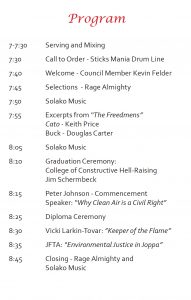
GET YOUR TICKETS HERE
Alternative Earth Day Event



